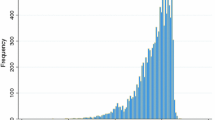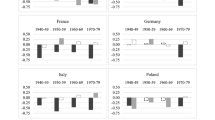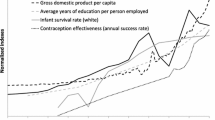Abstract
The trade-off between child quantity and quality is a crucial ingredient of unified growth models that explain the transition from Malthusian stagnation to modern growth. We present first evidence that such a trade-off indeed existed already in the nineteenth century, exploiting a unique census-based dataset of 334 Prussian counties in 1849. Furthermore, we find that causation between fertility and education runs both ways, based on separate instrumental-variable models that instrument fertility by sex ratios and education by landownership inequality and distance to Wittenberg. Education in 1849 also predicts the fertility transition in 1880–1905.
Similar content being viewed by others
References
Abramitzky R., Delavande A., Vasconcelos L. (2010) Marrying up: The role of sex ratio in assortative matching. Stanford University, Mimeo
Angrist J. D. (2002) How do sex ratios affect marriage and labor markets? Evidence from America’s second generation. Quarterly Journal of Economics 117(3): 997–1038
Angrist, J. D., Lavy, V., & Schlosser, A. (2005). New evidence on the causal link between the quantity and quality of children. NBER Working Paper 11835. Cambridge, MA: National Bureau of Economic Research.
Becker G. S. (1960) An economic analysis of fertility. In: Becker G. S. (ed) Demographic and economic change in developed countries. Princeton University Press, Princeton, NJ, pp 209–240
Becker G. S., Lewis H. G. (1973) On the interaction between the quantity and quality of children. Journal of Political Economy 81(2, part 2): S279–S288
Becker G. S., Tomes N. (1976) Child endowments and the quantity and quality of children. Journal of Political Economy 84(4, part 2): S143–S162
Becker S. O., Woessmann L. (2008) Luther and the girls: Religious denomination and the female education gap in 19th century Prussia. Scandinavian Journal of Economics 110(4): 777–805
Becker S. O., Woessmann L. (2009) Was Weber Wrong? A human capital theory of Protestant economic history. Quarterly Journal of Economics 124(2): 531–596
Becker S. O., Woessmann L. (2010) The effect of Protestantism on education before the industrialization: Evidence from 1816 Prussia. Economics Letters 107(2): 224–228
Bengtsson T., Dribe M. (2006) Deliberate control in a natural fertility population: Southern Sweden, 1766–1864. Demography 43(4): 727–746
Berger H., Spoerer M. (2001) Economic crisis and the European revolutions of 1848. Journal of Economic History 61(2): 293–326
Black S. E., Devereux P. J., Salvanes K. G. (2005) The more the Merrier? The effect of family size and birth order on children’s education. Quarterly Journal of Economics 120(2): 669–700
Bleakley H., Lange F. (2009) Chronic disease burden and the interaction of education, fertility, and growth. Review of Economics and Statistics 91(1): 52–65
Breierova, L., & Duflo, E. (2004). The impact of education on fertility and child mortality: Do fathers really matter less than mothers? NBER Working Paper 10513. Cambridge, MA: National Bureau of Economic Research.
Brown J. C., Guinnane T. W. (2002) Fertility transition in a rural, Catholic population: Bavaria, 1880–1910. Population Studies 56(1): 35–49
Brown J. C., Guinnane T. W. (2007) Regions and time in the European fertility transition: Problems in the Princeton project’s statistical methodology. Economic History Review 60(3): 574–595
Cervellati M., Sunde U. (2005) Human capital formation, life expectancy, and the process of development. American Economic Review 95(5): 1653–1672
Cervellati, M., & Sunde, U. (2009). Life Expectancy and economic growth: The role of the demographic transition. IZA Discussion Paper 4160. Bonn: Institute for the Study of Labor.
Clark G. (2007) A Farewell to Alms: A brief economic history of the world. Princeton University Press, Princeton, NJ
Coale A. J., Watkins S. C. (1986) The decline of fertility in Europe. Princeton University Press, Princeton, NJ
Cubberley E. P. (1920) The history of education. Cambridge University Press, Cambridge, UK
Doepke M. (2004) Accounting for fertility decline during the transition to growth. Journal of Economic Growth 9(3): 347–383
Doepke M. (2005) Child mortality and fertility decline: Does the Barro-Becker model fit the facts?. Journal of Population Economics 18(2): 337–366
Flora, P., Kraus, F., Pfenning, W. (eds) (1983) State, economy and society in Western Europe 1815–1975. St. James Press, Chicago, IL
Galloway P. R., Hammel E. A., Lee R. D. (1994) Fertility decline in Prussia, 1875–1910: A pooled cross-section time series analysis. Population Studies 48(1): 135–158
Galloway P. R., Lee R. D., Hammel E. A. (1998) Urban versus rural fertility decline in the cities and rural districts of Prussia, 1875 to 1910. European Journal of Population 14(3): 209–264
Galor O. (2005) From stagnation to growth: Unified growth theory. In: Aghion P., Durlauf S. N. (eds) Handbook of economic growth. Elsevier, Amsterdam, pp 171–293
Galor O. (2005) The demographic transition and the emergence of sustained economic growth. Journal of the European Economic Association 3(2-3): 494–504
Galor O. (2010) Unified growth theory. Princeton University Press, Princeton NJ (forthcoming)
Galor O., Moav O. (2002) Natural selection and the origin of economic growth. Quarterly Journal of Economics 117(4): 1133–1191
Galor O., Moav O. (2006) Das Human-Kapital: A theory of the demise of the class structure. Review of Economic Studies 73(1): 85–117
Galor O., Moav O., Vollrath D. (2009) Inequality in land ownership, the emergence of human capital promoting institutions, and the great divergence. Review of Economic Studies 76(1): 143–179
Galor O., Weil D. N. (1999) From Malthusian stagnation to modern growth. American Economic Review 89(2): 150–154
Galor O., Weil D. N. (2000) Population, technology, and growth: From Malthusian stagnation to the demographic transition and beyond. American Economic Review 90(4): 806–828
Goldin C., Katz L. F. (2008) The race between education and technology. Harvard University Press, Cambridge, MA
Guinnane T. W. (2008) The historical fertility transition and theories of long-run growth: A guide for economists. Yale University, Mimeo
Guinnane T. W., Okun B. S., Trussell J. (1994) What do we know about the timing of fertility transitions in Europe?. Demography 31(1): 1–20
Hajnal J. (1965) European marriage patterns in perspective. In: Glass D. V., Eversley D. E. C. (eds) Population in history: Essays in historical demography. Edward Arnold, London, pp 101–143
Hansen G. D., Prescott E. C. (2002) Malthus to solow. American Economic Review 92(4): 1205–1217
Hanushek E. A. (1992) The trade-off between child quantity and quality. Journal of Political Economy 100(1): 84–117
Jayachandran S., Lleras-Muney A. (2009) Life expectancy and human capital investments: Evidence from maternal mortality declines. Quarterly Journal of Economics 124(1): 349–397
Kalemli-Ozcan S. (2003) A stochastic model of mortality, fertility, and human capital investment. Journal of Development Economics 70: 103–118
Knodel J. E. (1974) The decline of fertility in Germany, 1871–1939. Princeton University Press, Princeton, NJ
Knodel J. E. (1988) Demographic behavior in the past: A study of fourteen German village populations in the eighteenth and nineteenth centuries. Cambridge University Press, Cambridge
Lucas R. E. (2002) Lectures on economic growth. Harvard University Press, Cambridge, MA
Moav O. (2005) Cheap children and the persistence of poverty. Economic Journal 115(500): 88–110
Qian, N. (2009). Quantity-quality and the one child policy: The only-child disadvantage in school enrollment in rural China. NBER Working Paper 14973. Cambridge, MA: National Bureau of Economic Research.
Rosenzweig M. R., Wolpin K. I. (1980) Testing the quantity-quality fertility model: The use of twins as a natural experiment. Econometrica 48(1): 227–240
Rosenzweig M. R., Zhang J. (2009) Do population control policies induce more human capital investment? Twins, birthweight, and China’s ‘One Child’ policy. Review of Economic Studies 76(3): 1149–1174
Schultz T. P. (2008) Population policies, fertility, women’s human capital, and child quality. In: Schultz T. P., John S. (eds) Handbook of development economics. Elsevier, Amsterdam, pp 3249–3303
Soares R. R. (2005) Mortality reductions, educational attainment, and fertility choice. American Economic Review 95(3): 580–601
Strulik H., Weisdorf J. (2008) Population, food, and knowledge: A simple unified growth theory. Journal of Economic Growth 13(3): 195–216
Willis R. J. (1973) A new approach to the economic theory of fertility behavior. Journal of Political Economy 81(2, part 2): S14–S64
Wooldridge J. M. (2002) Econometric analysis of cross section and panel data. MIT Press, Cambridge, MA
Author information
Authors and Affiliations
Corresponding author
Rights and permissions
About this article
Cite this article
Becker, S.O., Cinnirella, F. & Woessmann, L. The trade-off between fertility and education: evidence from before the demographic transition. J Econ Growth 15, 177–204 (2010). https://doi.org/10.1007/s10887-010-9054-x
Published:
Issue Date:
DOI: https://doi.org/10.1007/s10887-010-9054-x




